The onset of C. elegans dosage compensation is linked to the loss of developmental plasticity
- PMID: 24252776
- PMCID: PMC3891041
- DOI: 10.1016/j.ydbio.2013.11.001
The onset of C. elegans dosage compensation is linked to the loss of developmental plasticity
Abstract
Dosage compensation (DC) equalizes X-linked gene expression between sexes. In Caenorhabditis elegans, the dosage compensation complex (DCC) localizes to both X chromosomes in hermaphrodites and downregulates gene expression 2-fold. The DCC first localizes to hermaphrodite X chromosomes at the 30-cell stage, coincident with a developmental transition from plasticity to differentiation. To test whether DC onset is linked to loss of developmental plasticity, we established a timeline for the accumulation of DC-mediated chromatin features on X (depletion of histone H4 lysine 16 acetylation (H4K16ac) and enrichment of H4K20 monomethylation (H4K20me1)) in both wild type and developmentally delayed embryos. Surprisingly, we found that H4K16ac is depleted from the X even before the 30-cell stage in a DCC-independent manner. This depletion requires the activities of MES-2, MES-3, and MES-6 (a complex similar to the Polycomb Repressive Complex 2), and MES-4. By contrast, H4K20me1 becomes enriched on X chromosomes several cell cycles after DCC localization to the X, suggesting that it is a late mark in DC. MES-2 also promotes differentiation, and mes-2 mutant embryos exhibit prolonged developmental plasticity. Consistent with the hypothesis that the onset of DC is linked to differentiation, DCC localization and H4K20me1 accumulation on the X chromosomes are delayed in mes mutant hermaphrodite embryos. Furthermore, the onset of hermaphrodite-specific transcription of sdc-2 (which triggers DC) is delayed in mes-2 mutants. We propose that as embryonic blastomeres lose their developmental plasticity, hermaphrodite X chromosomes transition from a MES protein-regulated state to DCC-mediated repression.
Keywords: Chromatin; Dosage compensation; Epigenetics; Pluripotency.
© 2013 Published by Elsevier Inc.
Figures
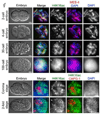
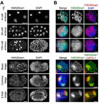
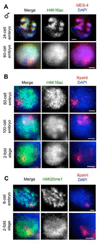
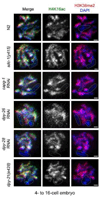

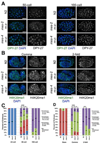
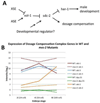
Similar articles
-
Caenorhabditis elegans dosage compensation regulates histone H4 chromatin state on X chromosomes.Mol Cell Biol. 2012 May;32(9):1710-9. doi: 10.1128/MCB.06546-11. Epub 2012 Mar 5. Mol Cell Biol. 2012. PMID: 22393255 Free PMC article.
-
H4K20me1 contributes to downregulation of X-linked genes for C. elegans dosage compensation.PLoS Genet. 2012 Sep;8(9):e1002933. doi: 10.1371/journal.pgen.1002933. Epub 2012 Sep 13. PLoS Genet. 2012. PMID: 23028348 Free PMC article.
-
Developmental Dynamics of X-Chromosome Dosage Compensation by the DCC and H4K20me1 in C. elegans.PLoS Genet. 2015 Dec 7;11(12):e1005698. doi: 10.1371/journal.pgen.1005698. eCollection 2015 Dec. PLoS Genet. 2015. PMID: 26641248 Free PMC article.
-
Condensin-mediated chromosome organization and gene regulation.Front Genet. 2015 Jan 13;5:473. doi: 10.3389/fgene.2014.00473. eCollection 2014. Front Genet. 2015. PMID: 25628648 Free PMC article. Review.
-
Condensin function in dosage compensation.Epigenetics. 2009 May 16;4(4):212-5. doi: 10.4161/epi.8957. Epub 2009 May 7. Epigenetics. 2009. PMID: 19483464 Review.
Cited by
-
XOL-1 regulates developmental timing by modulating the H3K9 landscape in C. elegans early embryos.PLoS Genet. 2024 Aug 15;20(8):e1011238. doi: 10.1371/journal.pgen.1011238. eCollection 2024 Aug. PLoS Genet. 2024. PMID: 39146391 Free PMC article.
-
Anchoring of Heterochromatin to the Nuclear Lamina Reinforces Dosage Compensation-Mediated Gene Repression.PLoS Genet. 2016 Sep 30;12(9):e1006341. doi: 10.1371/journal.pgen.1006341. eCollection 2016 Sep. PLoS Genet. 2016. PMID: 27690361 Free PMC article.
-
Chromatin Organization during C. elegans Early Development.DNA (Basel). 2024 Mar;4(1):64-83. doi: 10.3390/dna4010004. Epub 2024 Feb 22. DNA (Basel). 2024. PMID: 39717613 Free PMC article.
-
Condensin IDC, DPY-21, and CEC-4 maintain X chromosome repression in C. elegans.PLoS Genet. 2025 Apr 9;21(4):e1011247. doi: 10.1371/journal.pgen.1011247. eCollection 2025 Apr. PLoS Genet. 2025. PMID: 40203054 Free PMC article.
-
Balancing up and downregulation of the C. elegans X chromosomes.Curr Opin Genet Dev. 2015 Apr;31:50-6. doi: 10.1016/j.gde.2015.04.001. Epub 2015 May 16. Curr Opin Genet Dev. 2015. PMID: 25966908 Free PMC article. Review.
References
-
- Akhtar A, Becker PB. Activation of transcription through histone H4 acetylation by MOF, an acetyltransferase essential for dosage compensation in Drosophila. Mol Cell. 2000;5:367–375. - PubMed
-
- Barakat TS, Gribnau J. X chromosome inactivation in the cycle of life. Development. 2012;139:2085–2089. - PubMed
-
- Baugh LR, Hill AA, Slonim DK, Brown EL, Hunter CP. Composition and dynamics of the Caenorhabditis elegans early embryonic transcriptome. Development. 2003;130:889–900. - PubMed
Publication types
MeSH terms
Substances
Grants and funding
LinkOut - more resources
Full Text Sources
Other Literature Sources
Miscellaneous

